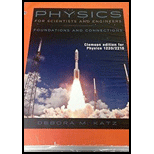
Concept explainers
CASE STUDY Concept Exercise 27.1 (page 829), we ignored air resistance acting on the ring launched by the experimenters in the case study. How would including air resistance change your answer to the question about the size of the spring? Does air resistance require that more, less, or the same amount of electric potential energy be stored in the spring? Explain your answers.
The size of the spring and the amount of potential energy when air resistance is considered.
Answer to Problem 1PQ
The size of the spring will be more compressed. And more potential energy is needed to attain the same final height.
Explanation of Solution
Write the equation for energy for a spring system.
Here,
If the air resistance is considered, the travelled height will be less. Again, the square of compressed distance is directly proportional to the height. Thus, the spring will be more compressed.
Due to air resistance, there will be a dissipation of mechanical energy. Thus, the total energy of the system will be reduced. To maintain that, there will be needed more amount of potential energy for the ring to attain the equal final height.
Want to see more full solutions like this?
Chapter 27 Solutions
Physics for Scientists and Engineers: Foundations and Connections
- No chatgpt pls will upvotearrow_forward8.114 CALC A Variable-Mass Raindrop. In a rocket-propul- sion problem the mass is variable. Another such problem is a rain- drop falling through a cloud of small water droplets. Some of these small droplets adhere to the raindrop, thereby increasing its mass as it falls. The force on the raindrop is dp dv dm Fext = + dt dt dt = Suppose the mass of the raindrop depends on the distance x that it has fallen. Then m kx, where k is a constant, and dm/dt = kv. This gives, since Fext = mg, dv mg = m + v(kv) dt Or, dividing by k, dv xgx + v² dt This is a differential equation that has a solution of the form v = at, where a is the acceleration and is constant. Take the initial velocity of the raindrop to be zero. (a) Using the proposed solution for v, find the acceleration a. (b) Find the distance the raindrop has fallen in t = 3.00 s. (c) Given that k = 2.00 g/m, find the mass of the raindrop at t = 3.00 s. (For many more intriguing aspects of this problem, see K. S. Krane, American Journal of…arrow_forward8.13 A 2.00-kg stone is sliding Figure E8.13 F (kN) to the right on a frictionless hori- zontal surface at 5.00 m/s when it is suddenly struck by an object that exerts a large horizontal force on it for a short period of 2.50 time. The graph in Fig. E8.13 shows the magnitude of this force as a function of time. (a) What impulse does this force exert on t (ms) 15.0 16.0 the stone? (b) Just after the force stops acting, find the magnitude and direction of the stone's velocity if the force acts (i) to the right or (ii) to the left.arrow_forward
- Please calculate the expectation value for E and the uncertainty in E for this wavefunction trapped in a simple harmonic oscillator potentialarrow_forwardIf an object that has a mass of 2m and moves with velocity v to the right collides with another mass of 1m that is moving with velocity v to the left, in which direction will the combined inelastic collision move?arrow_forwardPlease solve this questionarrow_forward
- Please solvearrow_forwardQuestions 68-70 Four hundred millilitres (mL) of a strong brine solution at room temperature was poured into a measuring cylinder (Figure 1). A piece of ice of mass 100 g was then gently placed in the brine solution and allowed to float freely (Figure 2). Changes in the surface level of the liquid in the cylinder were then observed until all the ice had melted. Assume that the densities of water, ice and the brine solution are 1000 kg m-3, 900 kg m3 and 1100 kg m3, respectively. 68 Figure 1 400 400 Figure 2 1m² = 1x10 mL After the ice was placed in the brine solution and before any of it had melted, the level of the brine solution was closest to 485 mL. B 490 mL. C 495 mL. Displaced volume by ice. D 500 mL. weight of ice 69 The level of the brine solution after all the ice had melted was A 490 mL B 495 mL D 1100kg/m² = 909 xious mis 70 Suppose water of the same volume and temperature had been used instead of the brine solution. In this case, by the time all the ice had melted, the…arrow_forwardPlease showarrow_forward
 Physics for Scientists and Engineers: Foundations...PhysicsISBN:9781133939146Author:Katz, Debora M.Publisher:Cengage Learning
Physics for Scientists and Engineers: Foundations...PhysicsISBN:9781133939146Author:Katz, Debora M.Publisher:Cengage Learning
 Principles of Physics: A Calculus-Based TextPhysicsISBN:9781133104261Author:Raymond A. Serway, John W. JewettPublisher:Cengage Learning
Principles of Physics: A Calculus-Based TextPhysicsISBN:9781133104261Author:Raymond A. Serway, John W. JewettPublisher:Cengage Learning Physics for Scientists and Engineers, Technology ...PhysicsISBN:9781305116399Author:Raymond A. Serway, John W. JewettPublisher:Cengage Learning
Physics for Scientists and Engineers, Technology ...PhysicsISBN:9781305116399Author:Raymond A. Serway, John W. JewettPublisher:Cengage Learning College PhysicsPhysicsISBN:9781305952300Author:Raymond A. Serway, Chris VuillePublisher:Cengage Learning
College PhysicsPhysicsISBN:9781305952300Author:Raymond A. Serway, Chris VuillePublisher:Cengage Learning




